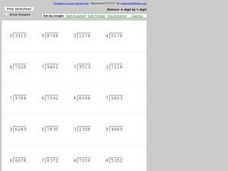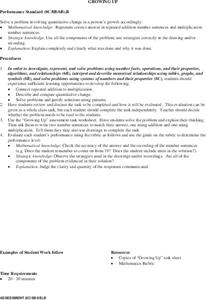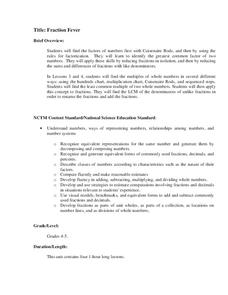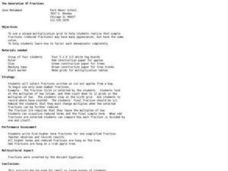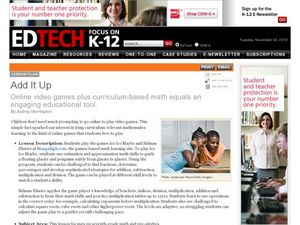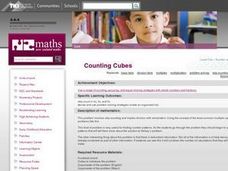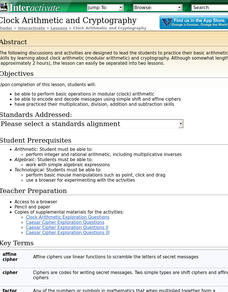Curated OER
Finding Addition Patterns
Students practice finding the sums of two-one digit numbers. In this addition lesson plan, students also record facts onto an addition chart.
Helping with Math
Division: Four Digit by One Digit
Lengthen learners' long division skills with this single-page handout. They must use problem solving skills to find the quotient when a four-digit number is divided by one digit. This is a nice assignment for early in the process of...
Curated OER
Visual and Number Patterns
Fourth graders develop strategies for identifying geometric and number patterns. In this mathematical patterns lesson, 4th graders use pattern blocks to make repeating patterns with numbers and shapes. Students then explore number...
Curated OER
Division Problems with 0 and 1
Students explore beginning division. In this division number properties lesson, students solve simple division story problems using cookies. Students create models that represent the identity and zero properties, then write explanations...
Curated OER
Dragon Math
Third graders, in groups, practice multiplication by putting five multiplication problems on white scales, then the answers on florescent colored scales.
Curated OER
Number in Geometry
Learners use a number line to assist with their additions. They use a calculator to check for factors. Students are taught factors and multiples. They use array model of multiplication to define meaning. Learners develop a wide range of...
Curated OER
Growing Up
Students solve a given problem and explain their thinking using two number sentences to match their answer. One number sentence must use addition, one must use multiplication, and students must explain their answers. Includes sample...
National Security Agency
Fraction Fever
This unit on fractions allows for upper-aged elementary learners to explore ways to find the greatest common factor and least common multiple of two numbers. Ultimately, young mathematicians will be able to identify equivalent fractions,...
Curated OER
Multiplying by 10, by 100, and by 1,000
Fourth graders write tenths and hundredths in decimal and fraction notations. In this math lesson, learners know the fraction and decimal equivalents for halves and fourths. Everyone answers numerous questions posed by the teacher...
Curated OER
Free Standing Structures
Learners investigate how to create a free standing structure. For this mathematics lesson, small groups of students demonstate how to build the tallest structure while spending the least amount of money on materials.
Curated OER
The Generation of Fractions
Pupils explore the process of reducing fractions to simplest form by using a multiples grid. In this simplest form lesson, students pull different fractions out of a bag and then consult their grid to discover all the multiples that...
Ahisma Summer Institute
The Power of One - Math in a Different Angle
In this 2-day lesson focused on exponents, middle schoolers will cross the curriculum by engaging in science, history and language arts activities. Exponential growth will be explored using grains of rice on a chess board. Exponential...
Curated OER
Number Operations
Inject fun into your math review! Pupils review basic math operations with decimals as well as addition and subtraction with simple fractions. In this number operations instructional activity, students work in groups to create a game for...
Illustrative Mathematics
Placing a Square Root on the Number Line
There are many ways to approach finding the rational approximation of an unknown square root. Here is a problem that will help math learners make a connection between square roots and their order on a number line. As usual, determine two...
Curated OER
The Multiplier (larger 2-digit by 1-digit numbers)
Students utilize number sense applications to multiply two digit numbers. They use "The Multiplier" and Internet source to partition and solve 2 digit by 1 digit multiplications. Students describe how to solve 2-digit by 1-digit...
Curated OER
Getting To School: Loving It Or Loathe It?
Learners engage in a study looking at the problem of transportation to school. They conduct research using a variety of resources. The information is used in order to work together to come up with possible solutions based upon current...
Curated OER
Math: Football League Statistics
Learners examine a soccer league final standings chart and then answer 12 questions based on the information provided. They calculate some answers in both fractions and percentages.
Curated OER
Fraction Trains
Students examine how multiples of the denominator indicate that a fraction can be renamed as a whole number, and convert improper fractions to mixed numbers. Independently they read examples, and complete a variety of problems on a...
Curated OER
More Pizzas and Things
Students are introduced to the problem by playing a guessing game of "I am a number, which is half of 6 and 6, what am I?" They explain their answers and see if anyone else had an alternate solution checking for reasonableness.
Curated OER
Online video games plus curriculum-based math equals an engaging educational tool.
Seventh graders use online math games to practice understanding the skill of estimation and order of operations. In this lesson, 7th graders use the internet to play online games to strengthen their understanding of these skills.
Curated OER
Writing a Number Sentence
Third graders analyze word problems. In this number sentence lesson, 3rd graders evaluate word problems. Students create number sentences from word problems.
Curated OER
Counting Cubes
Students count backwards in 2s from 30 then try other skip patterns such as 1,3,5, etc. and invent their own counting patterns. They are introduced to the problem using a pile of cubes and count by 2s and have a remainder.
Curated OER
Chocolate Math
Students practice solving math equations by analyzing chocolate recipe measurements. In this chocolate baking math lesson plan, students read about the Hershey factory and recipes used to create chocolate bars. Students solve problems...
Curated OER
Clock Arithmetic and Cryptography
Students investigate modular clock arithmetic and cryptography. They perform basic operations in modular (clock) arithmetic and encode and decode messages using simple shift and affine ciphers.

